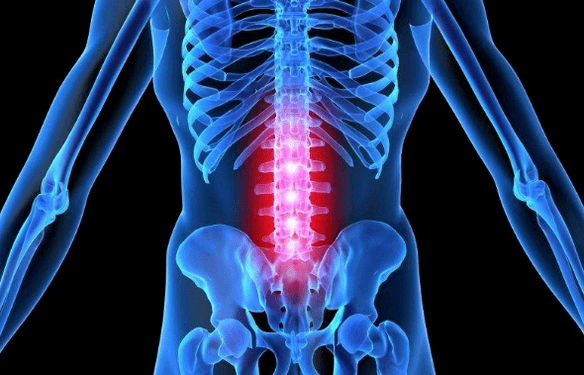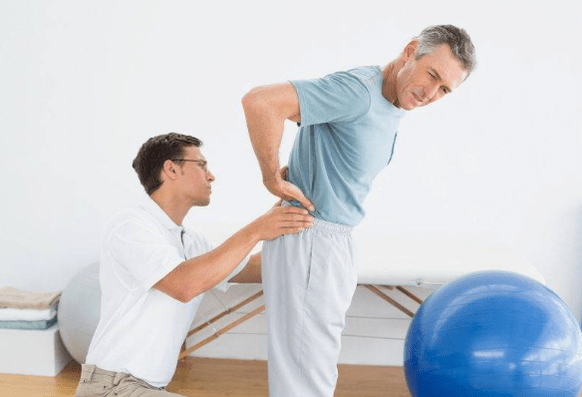Back pain often affects people after 35 years.In the vast majority of cases, the disease is associated with the deformation of the vertebrae and their consequences.The appropriate attractiveness to the doctor will accelerate recovery, because the symptoms and treatment of the osteochondrosis of the lumbar column are interconnected concepts.

The greater the progress of the disease, the more serious its consequences are, the more difficult the health restoration process is.
Signs and symptoms of the osteochondrosis of the lumbar column
The lumbar region is between the sacrum and the department of chests and consists of five vertebrae connected by intervertebral discs.
The development of osteochondrosis means the wear of the intervertebral discs that perform an absorbing role in the loads in the spine.The base of the discs is a mass similar to a gel, protected by a dense and cartilage fibrous ring, and the interior space is filled with a liquid octopo nucleus.
As the loads are lost in the vertebrae, the elasticity and flexibility of the intervertebral discs are lost, such as their height, and the micrographs are formed in the fibrous ring, which eventually leads to its breakup and damage to the pulpic nucleus.
The destruction of the tissues is accompanied by a pinch of nerve roots located on both sides of the vertebrae and causes severe pain.
The main signs of lumbar osteochondrosis:
- backache;
- fatigue and depression;
- excessive muscle weakness or tension;
- loss of sensitivity in the limbs, buttocks or hips;
- acute or sore pains and spasms in the lower back, often giving the legs;
- Violation of the motor function.
In the context of severe vertebral lesions, other symptoms are also observed in the lumbar region, more frequently, dysfunction of other organs: the urinary and sexual system, the gastrointestinal tract.
Causes
As most diseases of the musculoskeletal system, osteochondrosis can develop for many reasons.Some of them are found in the lifestyle and diet, the other part develops in the context of the physiological characteristics of the body.
Very often, the treatment of the osteochondrosis of the lumbosacra column is required by athletes whose back is subjected not only by constant power loads, but also by periodic lesions.
The second category of people who are at risk, people who, by virtue of their profession, spend a lot of time in one position: teachers, hairdressers, chefs, loaders, waiters, programmers, office workers and drivers.
Among other causes of the development of pathology:
- Overweight;
- Metabolism violation;
- inadequate, agitated posture;
- genetic predisposition;
- wounds;
- bad habits;
- the lack of benefits and beneficial vitamins in the diet;
- Abnormal development of the muscle bone system, flat feet;
- hypothermia;
- sedimentary, static;
- Frequent tensions.
All the factors listed can affect the elasticity of the intervertebral discs, since they contribute to a violation of the blood circulation or the appearance of a deficiency of nutrients that enter the vertebrates.
Degree of Lumbar Column Osteochondrosis
Depending on the level of damage to the column, the four degrees of development of the osteochondrial processes are distinguished, they manifest in the stages as the disease develops.
The first grade.
The pathological processes in the column begin long before their first clinical manifestation.As a result, moisture losses, intervertebral discs become less elastic elastic.The height of the discs is stored normal.The patient feels discomfort in the lower back.
The second grade.
At the bottom of moisture deficiency, micriects appear in the fibrous ring and tissue inflammation develops.The vertebrae hooks of the vertebrae gradually increase.In the cartilage there are stamps.The patient complains with back pain, giving his feet or groin.It is possible to limit motor capabilities.In the work of the internal organs, failures occur.
The third grade.
The integrity of the fibrous ring is disturbed, the intervertebral disc is in shape, forming a hernia.The vessels and nerve endings are compressed.Muscle spasms, pelvic organ dysfunctions, a sensitivity disorder of the lower extremities, prolonged attacks of radiculitis are observed.
The fourth grade.
The most complex, not susceptible to treatment, in the stage during the disease.As a result of the complete destruction of the intervertebral discs, the scars are formed in place.The vertebrae are to the maximum and gradually deform.With the development of spinal cord compression, the paralysis of the lower extremities is possible.
Diagnosis
To recognize the disease and determine the exact diagnosis, neurologists use a complex of measures: history of anamnesis, physiological examination and hardware studies.

HANG -Up Collection.
Establishes the study of the patient's complaints:
- the cause of anxiety;
- place of location of discomfort;
- Duration and intensity of unpleasant sensations;
- the duration of the disease;
- possible causes of the disease;
- frequency of exacerbations;
- factors that cause exacerbations;
- Factors that improve well.
In addition, the doctor studies information about the patient's lifestyle, diet, childbirth and rest, the presence of bad habits, hereditary factors and injuries.
Physiological examination
It is done to determine the pathological changes and make a preliminary diagnosis.
During the exam, the doctor evaluates the patient's motor capabilities: march, posture, amplitude and volume of movements.The palpation method examines the condition of the muscles: tone, size, volume of spasms.Using minor tingling, establishes the level of sensitivity.The recording with a hammer allows to discover the area of irradiation of pain.
Hardware research
To obtain complete and precise information on the location of the pathology and the degree of tissue lesions, doctors use research through various types of medical equipment.
Radiography.The study of the lumbar region through an X line allows us to establish anatomical parameters of intervertebral vertebrae and discs, the tendency to reduce holes between the bases, the presence of bone growth.
Tomography.The use of electromagnetic waves provides the image output of the area studied to the screen for subsequent study and analysis of the status of the blood vessels that feed the column tissue, nerve processes and intervertebral discs.
Connecticut.The images of several spinal segments are made using an X -Ray radiation.The image is shown in the monitor to determine the nature of the changes in the vessels, the membrane of the vertebrae and the spinal cord, and the regional growth.
For differential diagnosis, several types of studies are used to eliminate pathologies from other body systems.
Treatment of lumbosacral column osteochondrosis
The duration and characteristics of the treatment of lumbosacral osteochondrosis depend on the results of diagnostic measures.In the early stages of disease development, conservative treatment is indicated.With more complex lesions of the spine, surgical intervention is used.
The optimal therapeutic effect is achieved through complex therapy, which provides the use of local medicines, physiotherapy, massage and healing gymnastics.
Drug treatment
To relieve symptoms, non -steroid medications are prescribed for internal and external use: tablets, injections, ointments.In addition, condoprotectors, neuroprotectors, diuretics, vitamins, muscle relaxants are used.
Drug treatment allows:
- eliminate pain;
- eliminate inflammation;
- loosen the muscles;
- Restore the destroyed cartilaginous fabric;
- improve blood circulation;
- reduce swelling;
- increase physical activity;
- Normalize brain nutrition.
In acute pains, novocaine blockages are used that provide an instant effect.
Popular remedies
Treatment with popular methods is effective as an additional medication for pharmacological therapy.The main techniques of traditional medicine are based on the use of plant materials, animal products and chemical products.
According to several components, ointments and compresses, decoctions and infusions are prepared for internal and external use, as well as for therapeutic baths.
Physiotherapy for lumbar osteochondrosis
Physiotherapeutic procedures are an excellent way to restore the motor functions of the column after damage to osteochondrosis.
The main physiotherapeutic methods include:
- Electrotherapy: Exposure to weak electric currents to improve blood circulation in tissues;
- Magnetotherapy: the use of magnetic fields to restore tissues at the cellular level;
- Laser therapy: Integral activation of biological processes in vertebrates and nerve endings;
- Shock wave therapy: an improvement in microcirculation and metabolic processes in tissues affected by the effect of an acoustic wave;
- Balneotherapy: the use of the healing properties of mineral water.

Physiotherapeutic procedures not only increase the effectiveness of pharmacological treatment several times, but also contribute to the healing and strengthening of the body as a whole.
Massage for Lumbar Osteochondrosis
Visiting massage procedures is one of the most pleasant and effective methods to treat osteochondrosis.
Use of therapeutic massage:
- eliminate muscle cramps;
- Improve blood supply to the affected areas;
- improve the output of lymph;
- Restore the muscles that have exposed atrophy;
- Eliminate mobility restriction.
The massage is prescribed when the pain syndromes are eliminated.
Therapeutic gymnastics
The main task of exercise therapy for osteochondrosis is to restore the functionality of the spine and its correction.However, you can attend classes only after eliminating exacerbation symptoms.
The most effective methods of therapeutic exercises are considered:
- charger;
- Visiting the gym;
- Water therapy, swimming.
At home, you can use a sports ring.Some doctors to restore the flexibility of the column recommend yoga lessons to their patients.
Excessive osteochondrosis exercises
Any exercise for osteochondrosis should be done slowly and without sudden movements.
To strengthen the muscles that support the vertebrae, the exercises performed in the stomach are approaching.In this case, the hands stretch with a slight sip, but without tension.Repeat 4 times.
Surgical intervention
They resort to the treatment of the column in particularly difficult cases, with significant neurological disorders, as well as in case of loss of control over intestinal movements.
In the course of surgical intervention, the elimination of the disease source is guaranteed and measures are carried out to stabilize the spine.The postoperative period lasts several months.
Why is lumbar osteochondrosis dangerous?
Degenerative changes that occur with lumbar osteochondrosis contribute to the development of many dangerous diseases for human life.In the context of intervertebral hernia, bump, Lumbago and Ishias arise.
The additional progress of the disease can cause the fall of the intervertebral disc and the formation of Spinoz.In addition to the severe pain that accompanies the pathologies, the motor capabilities of a person are violated, to the complete loss of them.The paralysis of the lower extremities develops.
With significant damage to the spinal cord membrane, death is inevitable.
Prevention
To avoid destructive changes in the column, you must take care of a healthy lifestyle:
- do sports: swimming, hardening;
- Adhere to good balanced and balanced nutrition;
- exclude bad habits;
- maintain the posture;
- Support the column during sleep using an orthopedic mattress.
In addition, it is advisable to avoid hypothermia, weightlifting.Women who wear high heel shoes are not recommended.
You can maintain lumbar health if you adjust your lifestyle and do not forget the importance of physical activity.


















